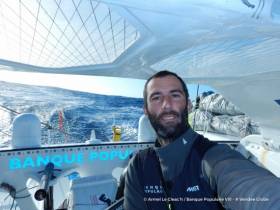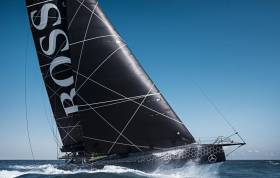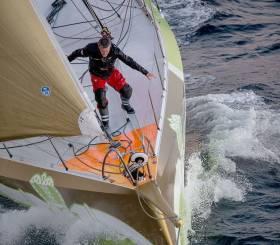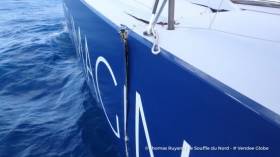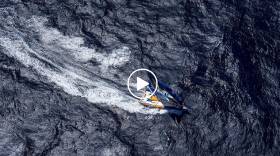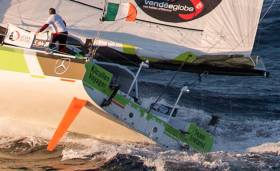Displaying items by tag: Vendee Globe
Enda O'Coineen's Vendee Globe: The Big Boys' Compared To Sydney–Hobart
The 72nd Rolex-Sydney-Hobart gets under way on Monday. The Australian ocean classic is rightly regarded as a tough event. Yet in terms of the sailing challenges its poses, it seems to pale into insignificance when set against the Everest of ocean racing, the Vendee Globe. But W M Nixon wonders if it’s fair on either event to try to make meaningful comparisons.
Just ten days ago on December 14th, the IMOCA 60 St Michel-Virbac, racing in the Vendee Globe Race, came speeding through the Bass Strait between Tasmania and mainland Australia, eastward bound for Cape Horn. Her skipper Jean-Pierre Dick – who won the 2007-2008 Barcelona World race as co-skipper with Ireland’s Damian Foxall – was seeking some shreds of shelter from a huge storm raging in the Great Southern Ocean between Tasmania and Antarctica.
It is the first time in the history of the Vendee Globe that a boat has diverted so far north and used the channel between Tasmania and Australia. But then, under the ice-avoiding conditions stipulated for the current edition of the race, the whole fleet has probably been further north than it might have been in time past.
Be that as it may, when this race is over the analysts will debate whether or not St Michel-Virbac gained or lost from her tactic. For now, all we know is that she currently lies fourth overall, having moved up a place when the Marcus Hutchinson-managed Paul Meilhat of SMA had to pull out with a catastrophic keel mechanism ram failure on Wednesday December 21st. So the probability is that by easing up on the pressure, albeit briefly, St Michel-Virbac did herself no harm at all in the big picture.
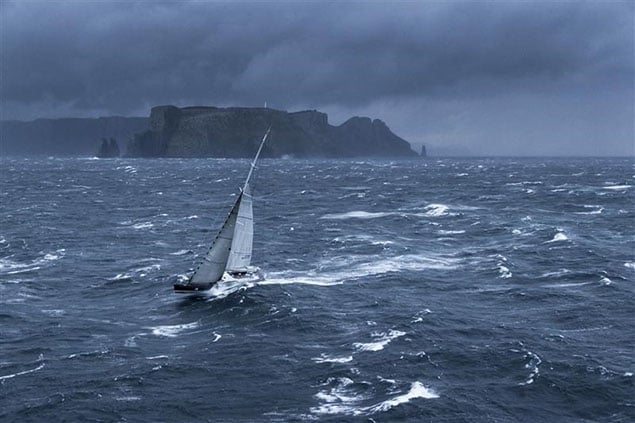 The waters of Tasmania in an unruly mood – the Swan 82 Nikata in the 2013 Rolex Sydney-Hobart Race. Photo Rolex
The waters of Tasmania in an unruly mood – the Swan 82 Nikata in the 2013 Rolex Sydney-Hobart Race. Photo Rolex
 Kilcullen Voyager may look ultra-modern to many sailors, yet she’s a ten year old veteran which lacks the hydrofoils of the most modern boats. Photo Team Ireland
Kilcullen Voyager may look ultra-modern to many sailors, yet she’s a ten year old veteran which lacks the hydrofoils of the most modern boats. Photo Team Ireland
As for Marcus Hutchinson, his challenges these past few days have been prodigious. Not only is he Race Director for the SMA team, but he and his colleagues have been giving a friendly hand to the much less heavily-resourced Team Ireland campaign which is doing what it can to keep the Enda O Coineen show on the road with the ten-year-old Kilcullen Voyager.
In fact, the two boats are light years apart, as SMA is one of the newest boats with hydrofoils (all five current leaders are so equipped, even if second-placed Alex Thomson Hugo Boss has lost his starboard foil), whereas Kilcullen Voyager is an old Mike Golding warhorse which has been round the block and then some.
 Paul Meilhart’s SMA has Marcus Hutchinson as Race Director, but after a very successful first half of the Vendee Globe, Meilhart is now out with a failed keel ram. Photo: Vendee Globe
Paul Meilhart’s SMA has Marcus Hutchinson as Race Director, but after a very successful first half of the Vendee Globe, Meilhart is now out with a failed keel ram. Photo: Vendee Globe
Yet now SMA is out of the race and the problem is to provide a rendezvous for her with a replacement keel ram which can be modified to fit her particular setup. But the doughty 60-year-old Enda O Coineen is still on track and moving steadily up the rankings despite setbacks which would have put many others out of contention.
The risks he’s had to take to keep it going defy the imagination. A sheet got well and truly fouled around one of his twin rudders, which meant he had to set the boat sailing on track such that the rudder was clear of the water on the weather side, and then he’d to clamber over that same wet and heaving side of the boat and perch on the rudder while he cleared the line.
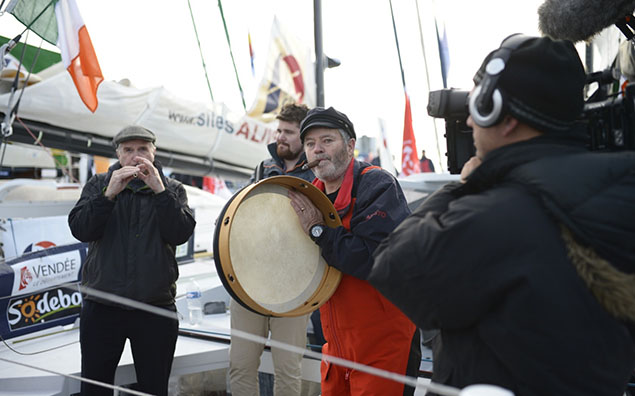 The party animal….Enda O Coineen with bodhran and cigar in Les Sables d’Olonne before the start
The party animal….Enda O Coineen with bodhran and cigar in Les Sables d’Olonne before the start
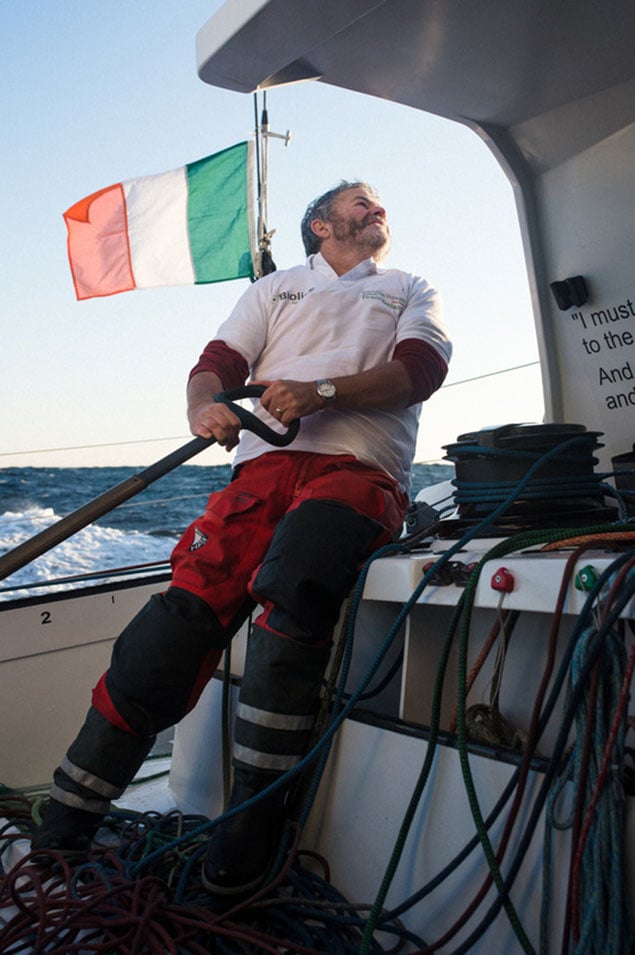 On his own, but the going is good. Enda O Coineen aboard Kilcullen Voyager getting the sort of sailing most of us dream of.
On his own, but the going is good. Enda O Coineen aboard Kilcullen Voyager getting the sort of sailing most of us dream of.
Even he admitted that he suffered a bit of a reaction to the all-or-nothing situation he had been in once he got safely back on deck. But since then his race has literally entered a darker phase as a massive knockdown has blanked out much of his electronics and knocked out his computer with the screen filled with water.
Even ashore in a fully-equipped workshop you’d be hard put to set that right. But in washing machine mode at top cycle, it’s a genius-defying predicament, yet his main men on land - Neil O’Hagan with Marcus Hutchinson - are doing everything possible while Marcus at the same time is seeing through the support programme for Paul Meilhart and the crippled SMA.
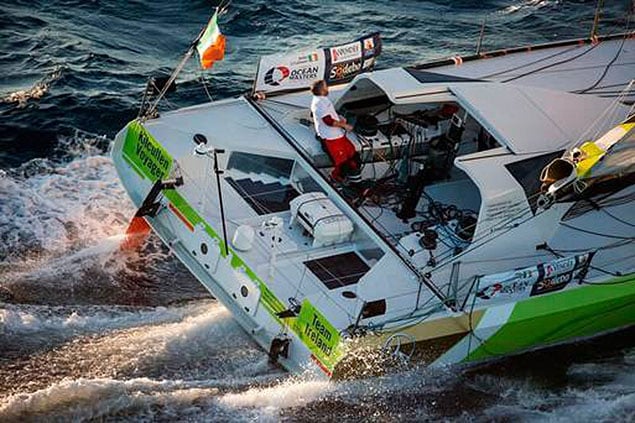 Aboard Kilcullen Voyager, the lone skipper has had a best day’s run of 395 miles. But now after electronic damage following a knockdown, he is back to basics with a small GPS and paper charts.
Aboard Kilcullen Voyager, the lone skipper has had a best day’s run of 395 miles. But now after electronic damage following a knockdown, he is back to basics with a small GPS and paper charts.
For Enda, it has been back to paper charts, a small GPS, and eyeball navigation with very red eyeballs. But by yesterday he was south of Australia, lying 13th overall out of 29 starters, and later today he hopes to be passing well south of Tasmania. Meanwhile in Sydney the crew of 88 boats will be having very controlled Christmas festivities as they keep themselves in competition-ready condition for the lunchtime start of the Rolex Sydney-Hobart Race on December 26th, with Tasmania and the Bass Strait very much in mind.
Back on December 14th, it was difficult to resist the temptation to draw smart-ass comparisons between the fact that a single-handed skipper racing in the Vendee Globe came whizzing through the Bass Strait for a brief experience of easier going, yet just two weeks later the crews the Hobart dash – the 72nd - reckon they’re the hard men (and women), and then some, to be facing into the crossing of the same Bass Strait.
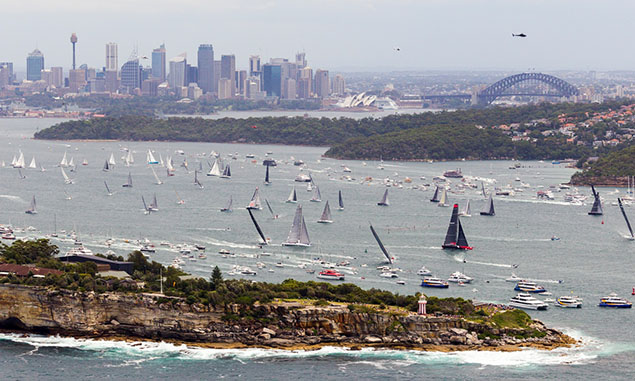 It’s an evocative part of world sailing’s fabric – the classic start of the Rolex Sydney-Hobart Race, down the harbour and out into the Tasman Sea. Photo Carlo Borlenghi/Rolex
It’s an evocative part of world sailing’s fabric – the classic start of the Rolex Sydney-Hobart Race, down the harbour and out into the Tasman Sea. Photo Carlo Borlenghi/Rolex
 The race to Hobart as popularly imagined – slugging it out across the Bass Strait. Photo Rolex
The race to Hobart as popularly imagined – slugging it out across the Bass Strait. Photo Rolex
But apart from the geographic proximity, comparisons are scarcely valid. The Rolex Sydney-Hobart Race is a 630-mile sprint in which mostly amateur crews endure oceanic conditions of all kinds for a relatively brief period of sometimes very scary stuff, knowing that at any time a port is within a day’s sail provided their boat hasn’t been totally incapacitated.
That said, people have been lost racing to Hobart, with six being drowned in 1998’s race when a storm swept through the Bass Straits. But it was a disaster from which much was learned and is unlikely to be repeated, even though the sudden changeability of the weather in the course region, despite it being the Australian summer, is something more extreme than in most European experience.
Nevertheless, the Vendee Globe, despite its huge media machine and technically savvy shore support teams, ultimately comes down to just one lone sailor racing an enormous and demanding machine with sails of a size which in times past would have been considered unthinkable as a solo command.
Admittedly when in the region of Tasmania, these skippers are mostly sailing downwind, whereas the crews racing to Hobart can expect a windward slugging match. But in the mighty flowing tapestry which is the weather of the Great Southern Ocean, every so often the approach of yet another low pressure system will force the Vendee Globe Skippers to put in some harsh windward work before the fronts sweep through and they can get back to the business of fast offwind sailing which recently has seen the race leaders pass Point Nemo, that imaginary spot in the Southern Ocean way south of the Pacific which is the furthest possible point on the planet from the nearest land – 1,670 miles.
That’s a helluva sight further from the nearest land than you’ll be when sailing in the Bass Strait, where Jeanne-Pierre Dick reported on his culture shock - after so many days of lone sailing on open ocean - at seeing evidence of habitation in the form of wind turbines. With all due respect to the skipper of St Michel-Virbac, most of us experience culture shock at seeing a formerly-beloved landscape suddenly polluted with wind farms, but we know what he meant.
Be that as it may, the very thought of Point Nemo is enough to give your ordinary human being the frights, but the Vendee Globe racers have to take it in their stride, in fact they scarcely notice it as the main points are the real land ones, with Cape Horn in all its notorious glory now coming centre stage.
On Monday, there’ll be 88 boats coming centre stage in the natural amphitheatre of Sydney Harbour, and with the time of year that’s in it, the Rolex Sydney-Hobart Race is one of the most keenly-followed sailing classics in the world for the simple reason that most of the world’s sailing population lives in the northern hemisphere, and it offers a wonderful escape from the rigours of a winter Christmas.
 The First 40 Breakthrough will have Ireland’s Barry Hurley as Sailing Master in Monday’s Rolex Sydney-Hobart Race
The First 40 Breakthrough will have Ireland’s Barry Hurley as Sailing Master in Monday’s Rolex Sydney-Hobart Race
There’s considerable Irish interest – after all, ex-Pat Gordon Maguire has won it twice – but as well there’s a natural fascination with the comparision of the performance of different boat types in what amounts to full-size laboratory conditions.
Last time round, Maguire’s owner Matt Allen put himself in the tricky position of having to choose at the last minute between taking his Carkeek 60 Ichi Ban or his TP 52 of the same name – both were race ready with days to go. In the end they plumped for the Carkeek, and she had a reasonably good race. But the irony of it all was that the overall winner was the 2008-vintage TP 52 Balance, owned by Australia’s popular financial guru Paul Clitheroe.
He’s probably extra-busy these days guiding people through Australia’s current mini-recession, which has the entry down to 88 boats. If this trend continues, in the foreseeable future the Volvo Round Ireland Race, with its entry numbers rising to 63 in 2016, could be matching the Rolex Sydney-Hobart in fleet size, which really would be one for the books.
But that’s another day’s work. Right now, we can find Irish interest in Sydney in Gordon Maguire as sailing master aboard the TP52 Ichi Ban, in Barry Hurley of Malta but still Royal Irish YC in his CV as Sailing Master of the First 40 Breakthrough with Kenneth Rumball in the crew, and in Shane Diviney, originally of Howth but getting up to speed these days with the professional multi-hull scene Down Under, who is a crew-member aboard the successful Judel Vrolik 62 Chinese Whispers.
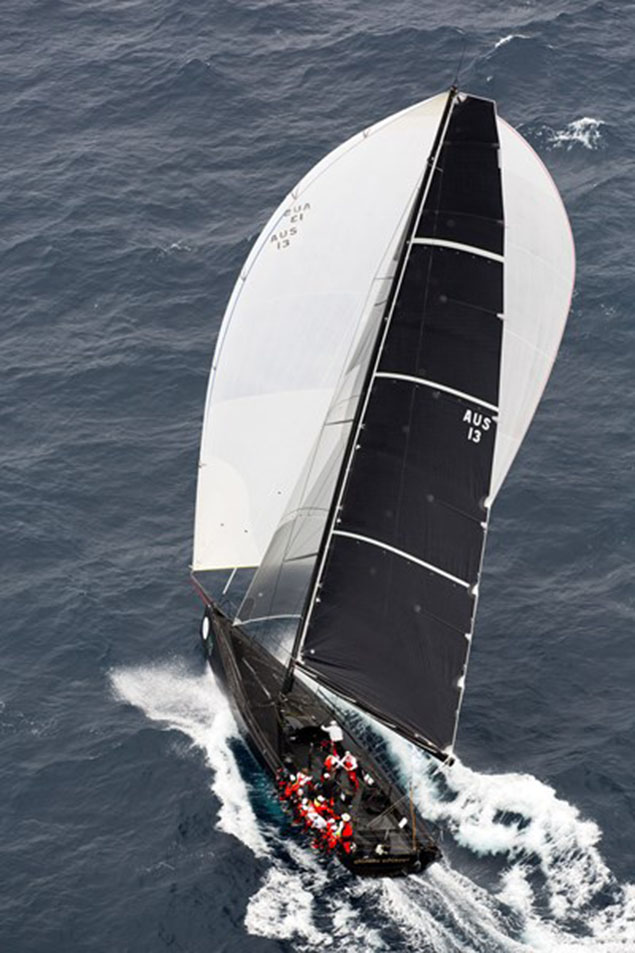 The successful JV62 Chinese Whispers has Ireland’s rising star Shane Diviney in her crew for the Rolex Sydney-Hobart Race.
The successful JV62 Chinese Whispers has Ireland’s rising star Shane Diviney in her crew for the Rolex Sydney-Hobart Race.
This is a boat which started life as Jethou purely for day racing at European venues, yet in Australia has proven to be a formidable performer offshore. As for others whose presence we might have expected, ace navigator Ian Moore – whose overall victory in the Middle Sea Race made him one of our “Sailors of the Month” in October – is taking a break to immerse himself in a family Christmas in Cowes after probably his most successful year ever, while for the rest of us the Rolex Sydney-Hobart Race will be a colourful interlude in the midst of the continuing mega-drama of the Vendee Globe.
Yesterday in this big one, the leader Armel Le Cleac’h rounded Cape Horn at 1234 UTC in Banque Populaire VIII with 595 miles in hand on the second-placed Alex Thomson in Hugo Boss. This margin may sound, well, it sounds stupendous – it’s just 35 miles short of the complete length of the Rolex Sydney-Hobart Race. But then the Vendee Globe is stupendous, and the men in it have shown themselves to be both superhuman and yet very human indeed.
 Banque Populaire VIII rounded Cape Horn at 1234 UTC yesterday. Photo Vendee Globe
Banque Populaire VIII rounded Cape Horn at 1234 UTC yesterday. Photo Vendee Globe
 Still racing. If the rate of attrition among other entries persists and his speed continues to improve, Enda O Coineen’s Kilcullen Voyager could finish in single figures in a race in which 29 started. Photo Team Ireland
Still racing. If the rate of attrition among other entries persists and his speed continues to improve, Enda O Coineen’s Kilcullen Voyager could finish in single figures in a race in which 29 started. Photo Team Ireland
Thus the really stupendous thing is that Enda O Coineen may be all of 5700 miles astern of the leader, yet we still feel he is very much racing. He is currently placed 13th overall, and he has it in him to move into single figures if the current rate of attrition persists, and he continues to show his guts and ingenuity in overcoming problems. His best day’s run – 395 nautical miles – was recorded as recently as December 9th.
Enda O Coineen arouses mixed feelings in those who have interacted with him in times past, but he has rightly endeared himself to the world, - and the Irish public in particular – with his tales of life on board the Kilcullen Voyager, and his delight in breaking into poetry at every opportunity. When the distinguished Tyrone-born poet John Montague passed away recently, Enda was right there with a reading from the great man’s works. But perhaps the most abiding member of this race will be from a sunny time when the going was good and Enda felt – with every justification – that the joys of the day merited a sunlit reading of Joseph Plunkett’s A Wave of the Sea, which certainly deserved it:
Kilcullen Voyager has even experienced poetry sessions
I am a wave of the sea
And the foam of the wave
And the wind of the foam
And the wings of the wind.
My soul’s in the salt of the sea
In the weight of the wave
In the bubbles of foam
In the ways of the wind.
My gift is the depth of the sea
The strength of the wave
The lightness of foam
The speed of the wind.
Now here in Ireland we are going through one winter storm after another, but the fishing boats are crowded safely in port, the Christmas homecoming flights have finally made it, and peace moves in on the land. It isn’t until Monday that the fleet races away down Sydney Harbour. Yet far out in the Southern Ocean and immediately past Cape Horn, those tiny specks are the Vendee Globe boats racing on through Christmas Eve, through Christmas Day, through everything. We wish them well, and wish everyone a very happy Christmas.
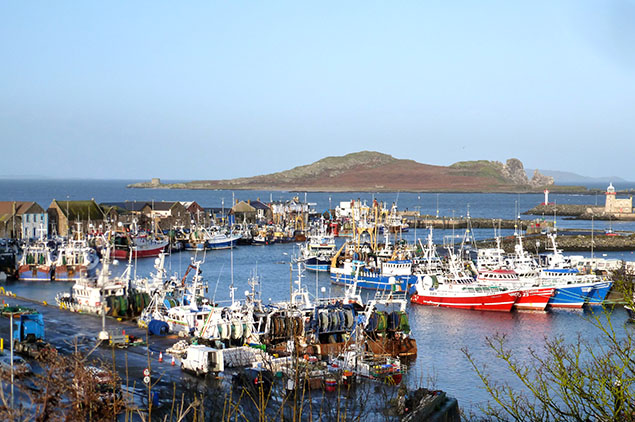 It’s Christmas, and the fishing fleet is safe in port. Howth as it was yesterday afternoon. Photo: W M Nixon
It’s Christmas, and the fishing fleet is safe in port. Howth as it was yesterday afternoon. Photo: W M Nixon
Le Cléac'h Leads Vendee Globe at the Horn
Armel Le Cléac'h is expected to lead the eighth edition of the Vendée Globe solo round the world race around its most feared but most universally welcomed landmark, Cape Horn, tomorrow around midday. The French skipper should pass the notorious southernmost tip of South America with the biggest lead since January 2001 when Michel Desjoyeaux led English skipper Ellen MacArthur by some 600 miles.
That over the ensuing seven days Desjoyeaux's lead over MacArthur in early 2001 was cut to some 140 miles in the sticky South Atlantic high pressure system, as that edition of the race effectively re-started there, will continue to give hope to second placed Alex Thomson on Hugo Boss. The only British skipper in this race struggled today with a very disorderly small low pressure cell which has slowed him still more while Le Cléac'h has remained relatively speedy. At 595 miles behind Banque Populaire VIII Thomson may find himself racing upwind, albeit on his favoured starboard tack tomorrow before finally making back some ground after Le Cléac'h passes the Horn.
3rd in 2008-9, 2nd in 2012-13, 1st in 2016-17?
For Le Cléach it will be the third time in successive editions of the Vendée Globe that he has rounded the Horn in the top three. In 2008-9 he was third behind Roland Jourdain and eventual winner Michel Desjoyeaux. And in the last edition he was just two and a half hours behind victor François Gabart. In the 2004-5 race Vincent Riou lead Jean Le Cam around Cape Horn by 15 hours and went on to win. Desjoyeaux led Roland Jourdain in early 2009 by nine hours and won the race ahead of Le Cléac'h after Jourdain's keel bulb dropped off south of the Azores.
After Alex Thomson established a new record for the stage from Les Sables d'Olonne to the Cape of Good Hope, on 24th November, some five days and one hour faster than the mark set in 2012 by Le Cléac'h, there looks set to be little in the way of significant net gain or loss on that advance since. A relatively fast Indian Ocean has been followed by a passive, complicated Pacific and so Le Cléac'h seems likely to pass in somewhere around 47 days. On this schedule Le Cleach should reduce the record of Francois Gabart by a matter of five days and some hours. At this same time on the first day of 2013, Gabart had slashed four days and nine hours off his mentor Michel Desjoyeaux's mark set in January 2009. Thomson will be buoyed by the expectation that the weather after Cape Horn does finally look a little more complicated for the race leader, who has enjoyed particularly smooth, assured transition periods, not least managing to multiply a margin of some 15 or so miles to the comfortable cushion he looks set to round Cape Horn by Armel Le Cléac'h.
SMA Solution
Paul Meilhat, who lay in third place, continues to plough a forlorn furrow northwards into lighter winds after his keel ram cracked. His team have found a solution, a replacement from Maître CoQ, the sistership which the SMA skipper spent 25 days racing alongside, and which raced as Le Cléach's Banque Populaire in 2012, duelling around the globe with MACIF which is the compromised SMA. Their plan seems to be to send a team to fit the replacement ram and SMA continue her course unclassified.
After a few very fast days on his foils since passing New Zealand Jean-Pierre Dick - who finished fourth in the last edition, is now up to fourth and 270 miles ahead of his closest rivals. But he has run into a ridge of high pressure. Yann Eliès (Queguiner-Leucémie Espoir) and Jean Le Cam (Finistère Mer Vent) have regained around thirty miles on JP Dick, while Jérémie Beyou (Maître CoQ) has accelerated. The South Pacific has its ups and downs, winners and losers, but this morning's life enhancing consolation for JP was a pod of dolphins dancing around his boat.
The race is close again too for the group of five entering the South Pacific. The youngest competitor in the fleet Alan Roura, 23-years old, with his boat which dates back to 2000 keeping up with four IMOCAs from the 2007-2008 generation. They are all within 145 miles of each other with Eric Bellion (CommeUnSeulHomme) still keeping his foot hard down. Over the past 48 hours, the 40-year old racing the powerful Finot Conq designed former DCNS, who sees the Vendée Globe as his big adventure has been the fastest in the fleet clocking up 400 miles a day and averaging 17 knots.
Four hundred miles from Melbourne, Australia, Stéphane Le Diraison the skipper of La Compagnie du Lit-Boulogne Billancourt has run into a wind hole. This is tough for the skipper, who was only making 4.5 knots when he had thirty knots of wind. Le Diraison has had to use his DIY talents to improve his jury rig. “I had kept around a ten square metre piece of the mainsail after the boat was dismasted. I have become a sail maker setting up a mainsail suitable for my rig. It's been successful. I have managed to raise my jury rig and now I have a bit more sail up. I shall be able to sail higher when I have headwinds. Otherwise there was the risk of ending up back where I started.”
Enda O'Coineen Lying in 14th Place in Vendee Globe But Computer Black Out Leaves Him (Almost) Out of Touch at Cape Leeuwin
Ireland's first ever Vendee Globe racer Enda O'Coineen is in 14th Place as the 27–boat round–the–world fleet as it passes another major milestone, Cape Leeuwin, the most south-westerly mainland point of the Australian Continent. But computer problems have left the Galway Bay solo sailor largely out out of touch and reliant on satellite phone. Here on Day 44/45, he updates Aflaot.ie readers from the Kilcullen Voyager:
'Our human capacity to adjust to new realities is amazing, whatever that may be. Like losing an arm, or a leg, or in my case computer navigation system. Something you thought you could not do without.
Now I’m nervous and afraid. As we go along the bottom of Australia and prepare for the vast unknown of the South Pacific before it meets the Antarctic. It’s also disturbing to hear that in recent days we have lost two, possibly three more boats. One due to a collision, one losing a mast, and most recently our friend Paul Meilhat of SMA with a keel hydraulic problem.
But at least there is my surprise Christmas package to look forward to on day 50 at sea. It should be somewhere south of Tazmania – though I confess to digging into the Chocolates last week during one of the storms.
After our backup system failed to work I was disorientated. I said I could not continue, particularly with the internet connection to the outside world, no weather information, news on other boats and so forth.
Now a few days later I have readjusted to the new reality and back in our “chart” around the planet. The outside world will also be spared from pictures and videos of the SORA President Elect and all the antics on board the good ship Kilcullen.
While the race is secondary to completing the objective of finishing and promoting our sponsors and the Atlantic Youth Trust. Nonetheless there is a strong desire to be in there, stay with the group, and have a respectable placing to do justice to the flag, team and boat.
There was a quiet satisfaction in passing Rich Wilson the other night on Great American IV. A deep thinking brilliant man, he has a degree in mathematics from Harvard and MIT and an impressive schools programme with 300,000 kids following his adventure.
Meanwhile rather than looking at what is not working, looking at what I have is a satellite phone, and a boat that’s functioning and we have a GPS position and paper charts. Also the race committee will allow us to get weather information by phone. We’re also constantly looking to find solutions and make do with what we’ve got. Also on the positive side with the exception of reefing problems on the main (which is very important in storms), the rest of our ship is in good shape and my daily routine and maintenance programme is never ending.
Finally, I learnt of a message from a young follower in Paris today, Milos. Sadly I'll have to wait until my computer is back up and running to see the card but thank you. It's somewhat strange to think you're all at home following this adventure and I can assure you it means a lot to me. The complexity of getting these logs to you is now greatly increased but I will endeavor to keep it up'
Enda O'C
Vendee Globe's Alex Thomson Sails past the Most Remote Place on Earth
Alex Thomson, the British Vendee Globe sailor who has strong links to Cork Harbour, has sailed past 'Point Nemo', the most remote point on planet earth.
Point Nemo, also known as the oceanic pole of inaccessibility, is the farthest point from land on our planet. Located within the Southern Pacific ocean between New Zealand and South America, the nearest landmass is 1,670 miles away. The remoteness of Point Nemo means that the nearest humans to Thomson and the Vendee Globe fleet are the astronauts in the International Space Station.
Thomson’s next milestone is Cape Horn, an infamous landmark in offshore racing where he will leave the ferocious Southern Ocean and re-enter the Atlantic Ocean. Rounding Cape Horn marks the point where the fleet turn their bows north again towards the finish line in Les Sable d’Olonne, France.
Thomson is still in second place racing against Frenchman Armel Le Cleac’h with 507.7 nautical miles between them.
Thomson has completed 64% of the race and is determined to be the first British skipper to win the race, which could take in the region of 80 days to complete.
Enda O'Coineen 'Sailing in the Dark' As Storms Batter Vendee Globe Sailors
The past three or four days have 'not been good' for Ireland's first entry in the Vendee Globe Enda O'Coineen (IRL) Kilcullen Voyager-Team Ireland has suffered a knockdown in a storm and has lost some communications equipment.
'Like everyone else in this part of the fleet we experienced two bad blows one after the other, I recorded up to 50kts at one stage. The first storm was bad and then about ten hours later the second one and during it I took a very bad knock down and the boat was on her side for about five minutes. When I hear about some of the other competitors I know I am not on my own. I am devastated for some, I don't want to hear about boats running into things. You never know what is going to happen, it is in the lap of the gods. I will say a few prayers at Christmas.'
O'Coineen is among a group five boats approaching the longitude of Cape Leeuwin, the SW tip of Australia with in order Fabrice Amedeo (Newrest-Matmut), Alan Roura (La Fabrique), O'Coineen (Kilcullen-Team Ireland), Rich Wilson (Great American IV) and Eric Bellion (CommeUnSeulHomme).
O'Coineen has been forced into a back to basic approach to navigation and routing on Kilcullen Voyager in 17th place. He lost two places when he took time out routing to the north to avoid the worst of the hard weather after being knocked down for five minutes. The Irish skipper reports that he now has no useful computer output after his main computer screen was damaged by water. He has a problem with the configuring of his back up computer which, it is understood, will not boot up. And so he has resorted to GPS fixes and paper charts.
“I am sailing in the dark to a certain extent. What I did to recuperate was to sail north towards Perth. I thought it would be a nice place for Christmas. I changed my mind. I effectively stopped for two days. But yesterday I got myself a little bit back together and I headed and south and east and now I am going east,” O'Coineen said today, adding “Spirits are good right now. You go through highs and low points, in the day, in the cycle and over the week. I have certainly had a couple of tough days and have had a lot of damage. Our shore team are trying to find a solution.”
Video from December 15:
Vendee Globe Entry 'On The Point of Splitting in Half'
Following the collision with an unidentified floating object late yesterday afternoon, the French skipper Thomas Ruyant (Le Souffle du Nord pour Le Projet Imagine) competing in the Vendée Globe is in serious difficulty. The 35 year-old skipper is in good health, but his boat is on the point of splitting in half. After spending the night hove to, Thomas Ruyant is attempting to motor to Bluff in New Zealand, which is 260 miles away from his seriously damaged boat.
TRANSLATION OF SKIPPER'S QUOTES:
“I have lowered the mainsail and am now motoring. I spent a few hours hove to. The damage at the front of the boat is spreading. The hull is opening up and the frame coming away a bit everywhere. I'm sailing to the south of New Zealand. I'm not sure if it will all stay in one piece until then. What's good is that I'm in helicopter range, which is reassuring. I just have to push a button and they'll come and get me. The inside hasn't been affected and with my watertight doors, I'm sheltered. The shock was exceptionally violent. It gives me the shivers just thinking about it. I was at 17-18 knots and came to a sudden standstill hitting what was probably a container seeing the damage it has done to the hull. The whole of the forward section exploded and folded up. Luckily the boat was not dismasted. It was really very violent. I was sleeping on my beanbag and fortunately I had my head down in that, as I ended up hitting the mast bulkhead. I found things that were stowed in the stern right up against the forward bulkhead. They got thrown 10m forward. I'm not far from the coast and I think I must be close to a shipping lane, which is perhaps the cause, as I have seen several cargo vessels. It must be the shipping lane between New Zealand and Australia. Given the seas down here, there are probably several containers in the water. I think that is what I hit given the violence of the crash. A nasty Vendée Globe. It's over. I got halfway around the world. I'm upset that it has come to an end like this. I've had my share of problems. A lot of problems, but this one, I wouldn't wish on anyone…”.
Vendee Globe Yacht Dismasted 770 Miles off Australia
At 1742 UTC on Saturday 17th December, Stéphane Le Diraison informed the Vendée Globe Race Directors that his Imoca Compagnie du Lit / Ville de Boulogne-Billancourt had dismasted.
The skipper was not injured and sounded in good health on the phone, when he called. He is currently in the process of sorting out the rig and will then carry out a complete check-up on his boat.
He was sailing in a 30-35 knot NW'ly wind, when the incident happened and is currently located 770 miles from the coast of Australia.
All of the project's sponsors are relieved that Stéphane is fine and remain 'in awe' of his performance during the race, during which he showed rigour and determination.
More news to follow.
Vendee Globe Sailors Pass Through Bass Strait To Avoid Storm
For the first time ever in the non-stop solo round the world Vendée Globe race's history, a competitor has gone through Bass Strait to avoid a storm in the Southern Ocean.
Frenchman Jean Pierre Dick (St Michel-Virbac) is the first Vendée Globe skipper ever to race through the Bass Strait. He was 45 nautical miles north of Devonport - half way across the north coast of Tasmania at 0400hrs TU this Wednesday. Dick was making 16kts and exited the Strait, and the shelter of Tasmania, at 0900hrs TU.
The French skipper has elected to sail a course over 400 miles north of the rhumb line, usual track, as he seeks to avoid a violent storm which is now passing to the south of him. A helicopter flew over Dick, a solo skipper who is lying in seventh place on his fourth successive Vendée Globe and has twice won the two handed Barcelona World Race around the world, in his first sight of other human life since he left Les Sables d'Olonne (France) on Sunday 6th November.
Quotes from the skipper:
“It's quite emotional going through the Bass Strait. It's very impressive with the wind getting up to 40 knots. I'm now going down towards New Zealand to get back into the Southern Ocean. You only get this sort of excitement in the Vendée Globe. I saw the coast of Tasmania and Clarke Island, which looked amazing. There are a lot of wind turbines, which proves that there is a lot of wind here. It's always strange getting back to civilisation, seeing earth and saying that we were in the Roaring Forties just a few days ago. Suddenly you are back in civilisation and it's a bit of a shock.”
Enda O'Coineen Climbs On to the Rudder to Free Jammed Lines
Ireland's first Vendee Globe competitor Enda O'Coineen climbed out over the stern of his round–the–world yacht to free a loose line. In 15th place overall from a fleet of 29, the Royal Irish Yacht Club sailor describes the latest obstacle to overcome on Kilcullen Voyager currently 600–miles east of the Kerguelen Islands, in the Southern Indian Ocean.
'This is hard. So that I can never, ever do something like this again, I will sign a legal binding document and give it to somebody in trust so that they can stop me from ever, ever, ever again doing something like this. It is tough, it is cold, it is wet and to think I did it with my own 'free-will' to live on the edge with constant challenges. The mind boggles, 'tis bonkers.
That said, I am thrilled to have survived this far. It has been an extraordinary adventure and personal journey, psychologically and physically. To boot, a good way to get fit! I am lucky and honoured to fly the flag and be in a position to have a go. The race organisers do a brilliant job. Thanks Laura Jacques and team. It is just wonderful to be part of and feel the emotional support, passion, celebrating the environment, the ocean, man against the elements and all that.
From reports some other skippers seem to have it tougher. I feel for them and note Conrad Coleman - on 100% Naturally, who has been performing extraordinary feats. And taking a line Mich Desj', two-time winner of the Vendee Globe, who says that you need to be mentally prepared for one major problem per day.
In one such problem on board Kilcullen, a mirror would have been useful, one which is on the "we forgot list." A sheet was jammed around the rudder and I could not see how or why. It was dangerous on the rudder and would not come clear. It would have been handy to look around the edge to see the problem.
In the end, we did an Alex Thomson. Namely canted the keel the wrong way and hardened the sails for the boat to heel and go more upwind. This worked. She was remarkably steady going along at an angle of about 60 degrees.
Then I climbed out over the stern and stood on the aft ledge and the port rudder was clear out of the water which I was able to stand on. Later that day a starboard sheet caught itself around the hydrogenator. Not as extreme, but another problem to be solved.
And having set out just of get around, it's not in my nature not to race or compete and to be 15th is just grand. Mr Motivator. And its been brilliant racing working to stay ahead of the American Rich Wilson, Alan Roura from Switzerland and Eric Bellion of France.
When the wind goes lighter we close up - and I suffer not being able to fly my asymmetrical sails. At some stages, we have been extremely close - we chat by email. At one time, I had warm VHF conversations with Alan and the mutual respect and support for what each is going through is powerful.
Our next landmark are the Kerguelen Islands, about 600 miles East. I am contemplating whether to pull in there to sort out my halyard problems and climb the mast.
After that its Cape Leeuwin off Australia the 2nd of the big 3 and after that its Cape Horn. Like eating the proverbial elephant, each day a little bit at a time'.
Enda O'Coineen
Lat 44 54 South
Long 55 40 West
Enda O'Coineen is now four weeks ino the Vendee Globe Race and reports from the Indian Ocean.
“Welcome to the Indian Ocean. Wow! The first to greet us was Rich Wilson on Great American IV. We trailed him by over 300 miles and finally caught him on the transition. I was feeling slightly smug and lucky that I was not having problems that other boats seemed to be having.
The day started normal. The wind was increasing so I thought I would furl the Blast Reacher and sail with the main alone with one reef and perhaps try the second. Then all hell broke loose. In preparing the furl line for the J3 became undone and the sail opened out of control. Then the furling line on the blast reacher broke leaving me stuck with two headsails out of control in the now gale force winds. Sheets and sails flogged, all wrapped around each other in a mess, as the wind howled. Then there was an involuntary gibe. As the boom crossed it caught in the runner and the boat, with the keel the wrong way, went on its side. Eventually I got to the keel hydraulics and pulled it up the other way and released the runner in the chaos while bringing the new one on. Rather than crash gybe back and risk serious damage, I continued the wrong gybe and set out to sort out the mess below and on deck. Fortunately, after a few hours the wrong gybe, the wind moved around and it became the right gibe.
To complicate matters the radar dome, one third the way up the mast - for no apparent reason - came loose and crashed down pulling the wires out of the mast. Fortunately, we saved the unit, but I am not sure it will work again on this voyage and minus an important safety tool.”



























